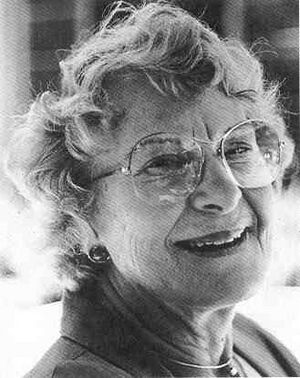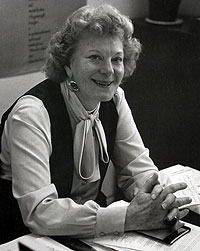Virginia Satir facts for kids
Quick facts for kids
Virginia Satir
|
|
|---|---|
 |
|
| Born | June 26, 1916 |
| Died | September 10, 1988 (aged 72) Menlo Park, California, U.S.
|
| Alma mater | Milwaukee State Teachers College (now University of Wisconsin-Milwaukee), (BA, 1936), University of Chicago (MSSA, 1948) |
| Occupation | Social worker, therapist, author |
| Known for | Family systems therapy |
| Spouse(s) | Gordon Rodgers (divorced 1949), Norman Satir (divorced 1957) |
| Children | 2 |
Virginia Satir (June 26, 1916 – September 10, 1988) was an American author and therapist. She was famous for her ideas about family therapy, which helps families work through problems together. Many people called her the "Mother of Family Therapy" because of her new ways of helping families.
Virginia Satir also created a special way to understand how people deal with change. It's called the Virginia Satir Change Process Model. This model helps explain how changes affect groups and organizations. She passed away in 1988 at the age of 72.
Contents
Virginia Satir's Early Life
Virginia Satir was born on June 26, 1916, in Neillsville, Wisconsin. She was the oldest of five children. When she was five, she became very sick with appendicitis. Her mother, who followed a certain faith, didn't want to take her to a doctor.
By the time her father decided to get her medical help, her appendix had burst. Doctors saved her life, but she had to stay in the hospital for many months.
Virginia taught herself to read when she was only three years old. By age nine, she had read every book in her small school's library. From a young age, she was interested in how families worked. When she was five, she decided she wanted to be a "children's detective on parents." She felt that "a lot went on in families that didn't meet the eye."
In 1929, her family moved to Milwaukee so Virginia could go to high school. This was during the Great Depression, a time when many people had little money. To help her family, Virginia worked part-time. She also took many classes to finish high school early.
In 1932, she graduated and started college at Milwaukee State Teachers College (now University of Wisconsin–Milwaukee). She worked for the government and a department store to pay for her studies. She also babysat to earn extra money. She earned a degree in education and worked as a teacher for a few years.
As a teacher, she noticed that parents who were involved and supportive helped their children a lot. She also saw that helping families could make a big difference. Virginia started working with her students' parents. She believed that "if we can heal the family, we can heal the world."
Starting in 1937, she took summer classes at Northwestern University in Chicago. Her interest in families led her to study social work at the University of Chicago. She earned her master's degree in social work in 1948.
Virginia Satir's Career as a Therapist
After finishing social work school, Virginia Satir started her own practice. In 1951, she began working with families. By 1955, she was at the Illinois Psychiatric Institute. She encouraged other therapists to focus on helping families, not just individuals.
Later, she moved to California. There, she helped start the Mental Research Institute (MRI) in Palo Alto. In 1962, MRI received money to start the first official family therapy training program. Virginia Satir became its training director.
Virginia Satir became a well-known therapist. She believed that the "surface problem" a family talked about was rarely the real issue. Instead, she thought the way people coped with problems created more difficulties. She also showed how low self-esteem could cause problems in relationships.
Virginia Satir also helped create groups to connect people. In 1970, she started a group called Beautiful People, which later became the International Human Learning Resources Network. In 1977, she founded the Avanta Network, which is now called the Virginia Satir Global Network. These groups helped people find mental health support and connect with others facing similar issues.
She received many special awards and honorary degrees. In 1978, she earned an honorary doctorate in Social Sciences from the University of Wisconsin–Madison.
Awards and Recognition
- 1976: Received a Gold Medal for "Outstanding and Consistent Service to Mankind" from the University of Chicago.
- 1978: Awarded an honorary doctorate from the University of Wisconsin–Madison.
- 1982: Chosen by the West German Government as one of the twelve most influential leaders in the world.
- 1985: Time magazine quoted a colleague saying, "She can fill any auditorium in the country."
- 1985: Selected by the National Academy of Practice to advise the U.S. Congress on health issues.
- 1986: Became a member of the International Council of Elders, a group created by Nobel Peace Prize winners.
- 1987: Named an Honorary Member of the Czechoslovakian Medical Society.
- She was honored in the California Social Work Hall of Distinction.
- In surveys of therapists, she was voted the most influential therapist.
Virginia Satir's Work and Influence
Virginia Satir's main goal was to help people become "More Fully Human." She believed that if families could heal, the world could heal too. She often said, "The family is a microcosm. By knowing how to heal the family, I know how to heal the world."
She set up training programs for her methods in many parts of the world. Her work helped people connect better with each other. Her message was simple: peace within yourself, peace between people, and peace among groups.
In the 1970s, her work was studied by the creators of neuro-linguistic programming (NLP). This is a way of understanding how people think and communicate. The Virginia Satir Global Network continues her work today.
Virginia Satir encouraged therapists to focus on teaching people about relationships. She believed that problems were just signs that something was wrong. She felt that therapy could help people grow and find more joy and connection in their lives.
Steve Andreas, a student of NLP, wrote a book about Virginia Satir's methods. He showed how she helped people, like a woman who learned to forgive her mother.
The Change Process Model
One of Virginia Satir's important ideas is the Process of Change Model. This model helps explain how people go through changes. It also shows how they can deal with these changes to improve their relationships. The model has four main stages:
Late Status Quo
In this first stage, everything is predictable and familiar. People have a set routine and fixed ideas about how things work. It's a time of stability.
Chaos
This stage begins when something changes in a person's life or surroundings. The old routine no longer works. This can bring strong feelings like sadness, fear, or confusion. Virginia Satir believed that therapists should help people navigate these difficult emotions during this stage.
Practice and Integration
In this stage, people start trying out new ideas and behaviors. They are figuring out what works best for them. Just like learning any new skill, it takes patience and practice.
New Status Quo
This is the final stage. The new ideas and behaviors become normal. People get used to the changes and become better at their new ways of doing things.
Virginia Satir pointed out that this change process isn't always a straight line. Sometimes, people might go back to the chaos stage if their new solutions don't work out. That's why it's important for therapists to understand this process to guide their clients.
Virginia Satir's Books
Virginia Satir published her first book, Conjoint Family Therapy, in 1964. It was based on the training materials she wrote for her students. Her reputation grew with each new book. She traveled the world to share her methods. She also received awards for her service in family therapy.
Virginia Satir often included meditations and poems in her workshops and books. One of her most famous writings is "I Am Me." She wrote it after an angry teenage girl asked her a question.
I Am Me
My declaration of self-esteem
I am me
In all the world, there is no one else exactly like me
Everything that comes out of me is authentically mine
because I alone chose it – I own everything about me
My body, my feelings, my mouth, my voice, all my actions,
whether they be to others or to myself – I own my fantasies,
my dreams, my hopes, my fears – I own all my triumphs and
successes, all my failures and mistakes Because I own all of
me, I can become intimately acquainted with me – by so doing
I can love me and be friendly with me in all my parts – I know
there are aspects about myself that puzzle me, and other
aspects that I do not know – but as long as I am
friendly and loving to myself, I can courageously
and hopefully look for solutions to the puzzles
and for ways to find out more about me – However I
look and sound, whatever I say and do, and whatever
I think and feel at a given moment in time is authentically
me – If later some parts of how I looked, sounded, thought
and felt turned out to be unfitting, I can discard that which is
unfitting, keep the rest, and invent something new for that
which I discarded – I can see, hear, feel, think, say, and do
I have the tools to survive, to be close to others, to be
productive, and to make sense and order out of the world of
people and things outside of me – I own me, and
therefore I can engineer me – I am me and
I AM OKAY
See also
- Family systems therapy
- Humanistic psychology
- Systems psychology
- Carl Whitaker
- Sally Pierone


